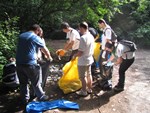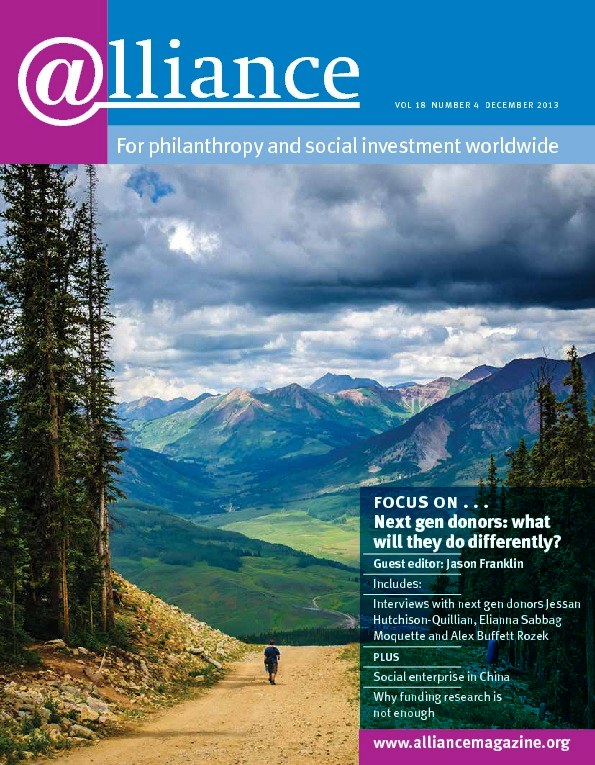A couple of years ago I got a call from a foundation seeking my opinion on a Romanian initiative. RoPot, the group in question, kept popping up in social media. They were inviting everyone to a conference on social enterprise. Had I heard of them? Yes, I got the invite. What did I know about them? Nothing. Eighteen months later, RoPot had become the highly successful, self-financing Bucharest Impact Hub, one of several similar organizations that have accomplished all this without the intervention of traditional philanthropy.
The rather pretty RoPot website did not shed much light on what they were doing. Yet their Facebook constituency continued to grow and included many friends then working in Romanian civil society. Asking around, I discovered they were led by a group of former AIESEC members who had recently quit corporate jobs in finance and marketing because they believed in Romania’s future and felt social economy had a role to play. They were reportedly smart, passionate and determined to do something.
The conference came and went. Much to my surprise (and contrary to the norm in Eastern Europe) participants paid to go. The resulting community apparently had a great time and determined a logical next step was to form an offline space in which to come together and keep building, learning and thinking.
Six months later I was renting office space from them in what later grew into the Bucharest Impact Hub – a fully self-financing co-working space that now has nearly 200 paying members occupying prime real estate in downtown Bucharest. In addition to office space for social enterprise start-ups, they offer consultancy and training services. They run highly successful regional conferences on social enterprise. They have accomplished this without the support of traditional philanthropy.
Not that they didn’t ask. But grantmakers were not quite ready to support a loose affiliation of thinkers and doers, driven by good intention but relying on community feedback for guidance rather than an easily digestible and matrixed three-year organizational strategy.
Network-first social change initiatives
RoPot is part of a social media enabled trend that is reshaping how civil society in much of the world forms and evolves. Driven by the communicative nature of social media, individuals can find out quickly if anyone else cares about the issues that keep them awake at night. As they shout out into the digital void, the social media echo chamber helps build constituency as people identify problems and organize around solutions. As people complain and resolve together, interest groups form and some begin to drift into offline social movements.
 These network-first social change initiatives are rapidly emerging as civil society champions, particularly in parts of the world with less formalized philanthropy: from the more purely political Arab Spring with its millions to RoPot, Let’s Do It (a voluntary clean-up-the-countryside movement which regularly brings out 150,000 plus individuals in Romania alone) and countless others. (Pictured: Let’s Do It volunteers on a cleaning project.)
These network-first social change initiatives are rapidly emerging as civil society champions, particularly in parts of the world with less formalized philanthropy: from the more purely political Arab Spring with its millions to RoPot, Let’s Do It (a voluntary clean-up-the-countryside movement which regularly brings out 150,000 plus individuals in Romania alone) and countless others. (Pictured: Let’s Do It volunteers on a cleaning project.)
Many of us are excited by this shift. After all, these grassroots (or perhaps more accurately webroots) initiatives epitomize the arc of traditional civil society development: an angry individual aggregates a community which may form an organization to take on systemic issues. These groups are organizing communities around individuals willing to change their patterns of behaviour and confront environmental issues from the bottom up. They are connecting real people in ways we all hope for, yet they often don’t see themselves as civil society at all.
Unlike many older organizations trained, for better or worse, to think about social change in terms of frameworks, ‘root issues’ and sustainability, these groups embody a more democratically driven participatory model in which leadership and plans are crowd-sourced. Many intend solely to bring people together to win a fight, while a few hope from the outset to evolve the organizational structures we are used to funding.
When do you take a Facebook page to a board of directors?
Noting their success in reaching and engaging masses of individuals in effective and meaningful ways, which is something most of us would clearly like to support, how and when do you take what may look like ‘just’ a Facebook page to a board of directors?
One approach to investing in web-rooted movements was offered by Elena Calistru, award-winning[1] founder of http://www.banipierduti.ro, at this year’s ‘Transparency’-themed Grantmakers East Forum in Belgrade in October. Calistru’s web-based tools track public spending and engage citizens in participatory budgeting. Her community of users embodies participatory democracy and is beginning to win battles against public administrations. Responding to the direct question about when traditional philanthropy mechanisms might be most useful, she stated: ‘Once we have tested a solution and have a community of users, we need support to start investing heavily offline in expanding range of activities from legal actions to the normal day-to-day things like getting an accountant and scaling what has proven successful.’
Asking established NGOs to carry out online campaigns
Another approach might be asking more ‘analog’ – ie traditional offline – organizations to prove their theories of change resonate with proposed beneficiary groups through social media campaigning. Many grantmakers practise an offline version of this by requiring some representation of community in the ‘need’ or ‘environment’ sections of grant applications. Usually the applicant populates this section of a grant with statistics and some balance of quantitative and qualitative ‘guesstimation’, which we accept on faith. An application backed by a social media-driven campaign, on the other hand, would offer insight into the size, shape, interaction and potential interest in behaviour change of a proposed beneficiary community.
This second approach, while ultimately educational, may not prove realistic for some organizations that lack the time and/or ability to run a successful online-to-offline campaign. If they are not supported to learn how to run such campaigns, they may fail miserably – which brings us to a third option.
Partnerships between web-based initiatives and established NGOs
Established NGOs often bring years of experience and ‘data’ on how systemic change happens. They have connections and the ability to influence legislative change. Yet many lack the broad constituency that adds weight to their conviction. If facilitated well, linking campaign-driven communities with NGOs confronting systemic issues might lead to a process in which citizens inform and participate in winning campaigns around issues they find most important and which are linked to specific, targeted, legislative initiatives. This combination of people and policy-making might begin to build truly empowering democratic processes, ultimately challenging the disenfranchising political environments which enable so many of the world’s ills.
Regardless of if or how you engage in linking social media to social change, from the more institutionally focused RoPot to the more decentralized-by-nature ‘Occupy’ movement, it is clear that network-based initiatives are establishing a track record of motivating communities around solving the issues they find most relevant; they are enabling real change.
These groups may remain a bit of a chimera to traditional investment models but as long as there are social media, they will keep forming, challenging our models of social change and the role of established civil society. It would be a shame not to explore bringing the two together and getting the best out of both worlds.
1 Calistru won an award from the Ashoka Foundation and Transparency International for her work with Bani Pierduti. More at http://15iacc.org/get-involved/social-entrepreneurs-main
Christopher Worman is director of program development at TechSoup Global. Email cworman@techsoupglobal.org






Comments (0)